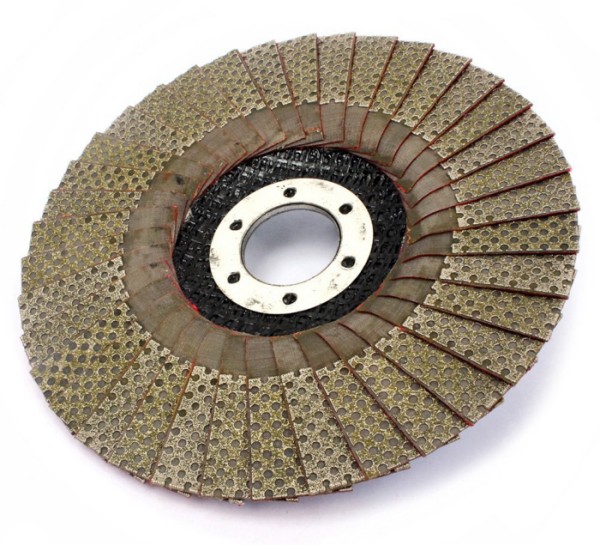Basic concepts of grinding disc and flap disc
Grinding disc
Composition: Abrasive discs, also known as grinding wheels, are round tools composed of abrasive grains, binders, fillers, etc. Abrasive grains, usually made of materials such as aluminum oxide, silicon carbide or diamond, provide the cutting and grinding action. Binders hold the particles together, and fillers help improve the disc’s performance and durability.
Function: Grinding discs are mainly used for grinding, sharpening, smoothing, and shaping of various materials such as metal, glass, ceramics, and stone. They are designed to remove material from workpieces by the abrasive action of the particles.
Applications: Grinding discs are commonly used in metal fabrication, woodworking, and other industries for applications such as material removal, surface preparation, weld blending, and smoothing rough surfaces.
Flap disc
Composition: A flap disc is similar to a grinding disc, but instead of a single grinding head, it consists of multiple overlapping abrasive lobes or plates arranged radially around a central hub. These sheets are usually made of emery cloth, coated sandpaper, or abrasive grain bonded to a backing material.
Function: The flap disc is a versatile grinding tool for a variety of applications. Mainly used for grinding, blending, finishing, and polishing of curved or irregular surfaces and corners. Due to their design, they are flexible and can conform to the shape of the workpiece, providing a consistent finish.
Application: Louver wheels are commonly used in metal fabrication, automotive, woodworking, and other industries. They are suitable for tasks such as weld blending, deburring, rust removal, surface cleaning, and light stock removal.
Difference between flap disc and grinding disc
Different uses: Grinding discs are mainly used for large-area surface processing after turning, milling, and planing. They effectively remove bare metal and improve surface smoothness. Flap discs, on the other hand, are great for grinding irregular shapes, small holes, bends, and other challenging surfaces. Their versatility in solving difficult areas makes them the first choice in various industries.
Different materials: Grinding discs are made of abrasive materials such as aluminum oxide, silicon carbide, silicon nitride, and diamond. These materials are combined with adhesives such as resins, rubber, ceramics, and metals. In contrast, flap discs mainly use materials such as corundum, alumina, and silicates. The material used determines the grinding efficiency and durability of each type.
Different structures: Grinding discs usually have a flat or inclined structure, with one or both sides of the grinding wheel. They are designed for efficient surface preparation and material removal. However, disc discs exhibit a unique comb-like structure comprising multiple grinding heads. This unique design can not only adjust the grinding posture conveniently but also can be customized by equipping the disc with multiple grinding heads as required.
Different applications: The applications of grinding discs mainly revolve around the machining, construction, and mining industries, where the machining of large surfaces is critical. Industries that commonly use grinding discs benefit from their ability to effectively remove large volumes of material. In contrast, thousand-petal discs are widely used in mold making, aerospace, automobile manufacturing, and medical equipment because of their ability to grind small holes and drive on irregular surfaces. Their adaptability makes them indispensable tools in these fields.
Knowing the difference between grinding discs and flap discs helps industries and individuals choose the most appropriate tool to achieve the desired results. Whether improving surface smoothness or handling challenging irregular shapes, the right choice can make all the difference in achieving efficient, high-quality grinding results. In summary, grinding discs are great for large surface machining, while flap discs excel at grinding irregular shapes and difficult surfaces. The materials, construction, and application used in these tools give them unique advantages in various industries. Make the smart choice and increase the efficiency and precision of your grinding tasks today.
How to choose suitable grinding discs and flap discs?
Workpiece hardness and shape: The hardness and shape of the workpiece play an important role in the selection of the appropriate grinding disc and flap disc. For workpieces with higher hardness, a grinding disc with harder material and higher wear resistance must be selected. This ensures efficient material removal without compromising the performance or life of the disc. Likewise, for irregularly shaped workpieces, flap discs have proven to be more versatile. Its adjustable and easy-to-handle features allow it to adapt to the unique contours and shapes of workpieces.
Size Compatibility: The size and shape of the grinding disc and flap disc should match the size of the workpiece to be machined. Choosing an improperly sized grinding disc will affect grinding efficiency and accuracy. Ensuring a proper fit avoids unnecessary complications and ensures consistent and accurate results. Preference is given to selecting a grinding disc that matches the size of the workpiece for the most efficient grinding process.
Applicable fields and quality requirements: Different industries and applications have different quality requirements for grinding discs and flap discs. Industries such as machining, metal fabrication, and construction require high-quality grinding tools that can withstand rigorous use.
When selecting a grinding tool, it is important to consider the specific field and its requirements. Look for products that meet these requirements to ensure optimal performance and durability. It is essential to consult a grinding specialist, manufacturer or supplier to obtain accurate information on suitable grinding discs and flap discs for a specific application. These professionals have valuable insights that can guide users to make informed decisions. By carefully considering the hardness and shape of the workpiece, selecting grinding discs with compatible sizes, and selecting products that meet the quality requirements of the relevant industries, users can choose the appropriate grinding discs and flap discs with confidence.
Post time: Sep-01-2023


